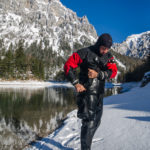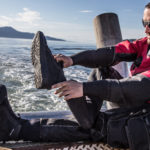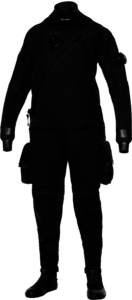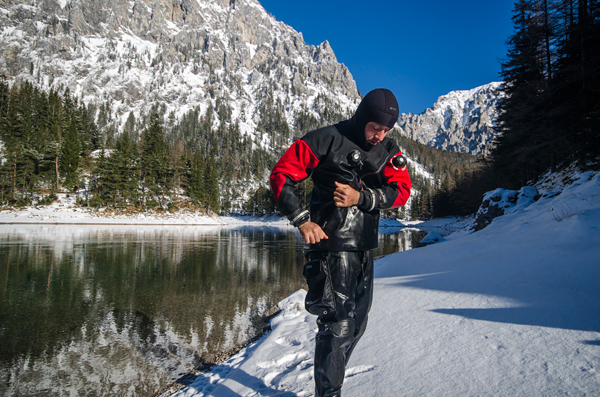As soon as you mention diving in New Zealand to any non diver you’re always faced with the same question “isn’t it cold?!” and I bet you answer the same way every time “well, yes and no. The water is freezing but I use the right gear to keep warm.”

Well for me using the right gear means using a dry suit. And since we have two new drysuits about to arrive in store; The Bare X-Mission Evolution and the Bare Sentry I thought I would try to shed a little light on why I dive dry and the two main styles of drysuit Trilaminate and Neoprene. So why dive dry? It’s out there cold. End of story.
But really it’s an important decision, making the move to a drysuit is relatively speaking expensive. Suits can cost anywhere from $1500 to $4500, so I guess the
question should be is it worth it? Well I decided to go dry when I realised how well winter diving is. In the summer seaweed thrives along with all the algae and other phytoplankton, for divers that means greener water and sometimes reduced vis. But in the winter there’s less growth so water clarity is often better (on the right day) wreck are more exposed and visible and its easier to find and explore new paths and channels at old dive sites. The only drawback is its freezing cold in winter! Being in a drysuit though, makes it perfectly comfortable. In my drysuit I can still do an hour long dive in 10 degree water and come out happy. Through me into a 7mm wetsuit and id be lucky to dive more than 30 minutes in winter. Being in a drysuit means I can (and do) dive all year round no matter the temperature. So yes investing in a drysuit is absolutely worth it if you ask me. All you need to decide no is which style to go for.

When I first started looking a drysuits I thought I was about to become the next James Bond. I could see myself swaggering out of the water as I unzip my suit to reveal a perfectly dry tux. Well I still haven’t been brave enough to try wearing a tux underneath but I can tell you coming out of 10 degree water bone dry and toasty warm is just as good as being Bond. My first drysuit was Trilaminate, like the name suggests this is three (tri) layers of waterproof material laminated (laminate) together to create a dry and durable suit. Trilaminate suits are typically favoured by technical divers or people who require a lot of versatility in their suits. It’s the outer most layer that has the appeal for the techies; basically manufactures can put super hard wearing materials on as the outer layer without sacrificing too much flexibility. The Bare X-Mission for example uses RipStop nylon making it super puncture resistant. You know how frustrating a tyre puncture is; well a hole in your drysuit is ten times worse, so having a hardy outer layer is well worth it. The other big advantage of a Trilaminate drysuit is versatility. Trilam suits have next to no warmth on their own so you need to add layers underneath to stay warm; but what layers you wear is up to you. So with a suit like the Bare X-Mission you might
wear a set of good thermals and a decent fleece in the warmer months but around June and July you can bump it up to a big thick purpose made undersuit. The benefit is that no matter how warm or cold the water is with a Trilaminate suit you can always adapt what you wear to match the water temp. When it comes to durability and versatility Trilaminate suits are the way to go, so it’s no surprise that technical divers and dive professionals mostly go this way, but they are a little bulky in the water not to mention more expensive than their counter parts Neoprene Drysuits.
For me I think Neoprene Drysuits are a great way to go for recreational divers. Imagine your wetsuit with much better wrist and neck seals, slap on a couple of inflation/deflation valves and that is pretty much a Neoprene drysuit. The great thing about Neoprene suits is that unlike Trilaminate suits they are inherently warm, so you don’t need to pack on the layers underneath.  The other thing that I really like about diving in Neoprene suits is they are much closer fitting and more streamlined in the water. It is important to keep in mind that not all neoprene suits are made equal. Broadly speaking there are two types: standard neoprene suits and compressed neoprene suits. Our new suit in store is the Bare Sentry, a compressed neoprene suit. Having compressed neoprene not only makes the suit more durable and compact but its real strength comes in buoyancy changes. The Bare Sentry has 2mm hyper compressed neoprene mean it was all the insulation properties of 5mm neoprene but won’t affect your buoyancy due to compression as you descend deeper and deeper on your dive. The payoff is less fluffing about with your BCD and drysuit inflator during the dive and you’re body temperature is more consistent.
The other thing that I really like about diving in Neoprene suits is they are much closer fitting and more streamlined in the water. It is important to keep in mind that not all neoprene suits are made equal. Broadly speaking there are two types: standard neoprene suits and compressed neoprene suits. Our new suit in store is the Bare Sentry, a compressed neoprene suit. Having compressed neoprene not only makes the suit more durable and compact but its real strength comes in buoyancy changes. The Bare Sentry has 2mm hyper compressed neoprene mean it was all the insulation properties of 5mm neoprene but won’t affect your buoyancy due to compression as you descend deeper and deeper on your dive. The payoff is less fluffing about with your BCD and drysuit inflator during the dive and you’re body temperature is more consistent.
I know it’s easy to get lost in all the waffle around features and differences between these two styles of suits so hopefully comparing the Bare X-Mission and Bare Sentry side by side will help you get a better idea of what’s what.
X-Mission 
Trilaminate
Favoured by techies and pros
No warmth (need to add layers to suit conditions)
Typically more flexible
Light weight and durable
Usually the more expensive option
Sentry

Compressed Neoprene
Suits recreational diving better
Inherently warm (only thin thermals required)
More streamlined and comfortable
When compressed very durable
Typically cheaper
Diving dry means I can be in the water all year round and still do nice long dives. But the choice to go dry isn’t an easy one. There are so many options out there, and choosing which one is best for you can be hard. You best bet is always to come down to the shop and ask us. Like I said drysuits are pretty dam popular with instructors and we all have our own opinions and experiences that can help guide you getting the right suit for you. As a starting point though, if you think drysuit diving is for you come down and check out the Bare X-Mission Evolution and Bare Sentry side my side and see the difference between Trilaminate suits and Neoprene. Whatever you decide, you won’t regret diving dry!
